history of design memerision final
1/5
There's no tags or description
Looks like no tags are added yet.
Name | Mastery | Learn | Test | Matching | Spaced |
|---|
No study sessions yet.
6 Terms
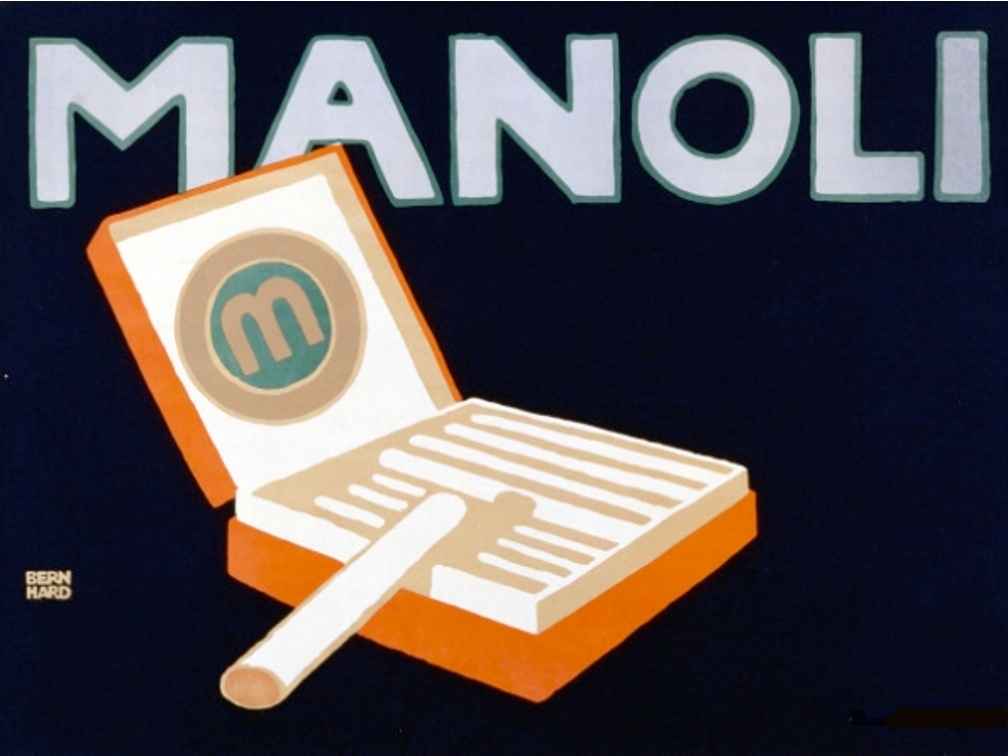
Lucian Bernhard
Poster for Manoli Cigarettes, German
1906, 12-7
graphic designer and
illustrator Lucien Bernhardt, an Austrian about whom not much is really known
He was very hesitant to tell people
details about himself, not even telling his children the same stories about his earlier life,
His original name
was Emil Khan, and he was probably Jewish. Antisemitism was rife in Germany and Austria at the time, so that he might have felt the need to keep quiet about his Jewish identity and let his work speak for itself.
His work was
certainly distinctive and in fact there's a German name for his approach, Plackett Style, although since that simply translates as poster style it isn't a very informative term.
What Bernard was attempting here was to simply raise consumer awareness of the brand so
so that the next time someone
craved a cigarette, the name Manoli would pop into their heads.
manliness to get men to associate this brand of cigarettes with being macho or anything like that, because there isn't a lot of text
promoting such ideas, nor is the product shown in situations that would raise those concepts. Instead, consumers would just
see a very simple image of the product and its brand name, so that the next time they thought about
cigarettes, they would also think about this brand.
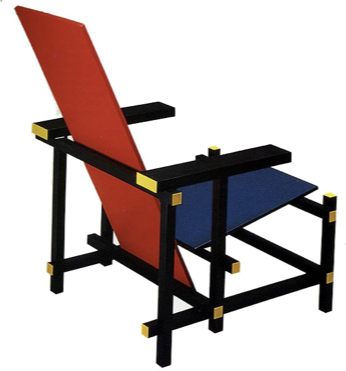
Gerrit Rietveld
Red Blue Chair
Dutch, De Stijl, 1917
Reed belt references
this concept by having the boards
he made the red blue chair from
all basic cuts of wood standard to
the building trades. They are uniformed components he could have purchased at any Dutch lumberyard
there are only three primary hues that can be combined to form all others, red, blue, and yellow. but those can’t be made
Here, Reatveldt
has only used black and the
three primaries, with white being
alluded to by the blank spaces within the form that a white backdrop like the one used here would show through.
Rietveldt suggests
those straight lines of force
stretching across infinity in a cosmic
grid by having his timbers extend
past each other. In a strictly
practical application, his various structural pieces should meet flush, because the little portions that go past their intersections do nothing to reinforce the stability of the chair and are, in fact, bits of dead weight. But having his little square beams extend past one another implies that what we see are just segments of longer, even endless lines
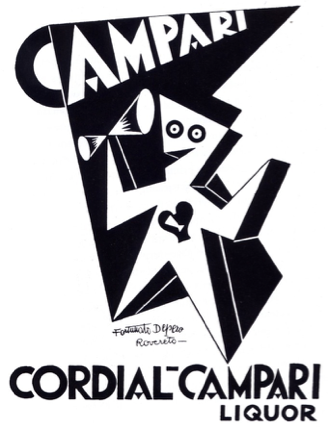
Fortunato Depero
Advertisement
for Campari
Italian
Futurism
c. 1927
The futurist emphasis
on restlessness and energy has here
been applied to an advertisement for the Italian liqueur, Campari, via the use of jagged diagonals and strong black and white contrasts.
its taste is sharp and tart, almost bitter so that to drink it is an attention
grabbing experience
Italians have long thought of Kampari. as being good for you, that it gives a beneficial jolt to your system, stimulating your heart and your appetite, so they traditionally have a little glass of it before a big meal.
Italians thought they did, and Depro's imagery certainly references those ideas with its
futurist agitated style. Like martinis
and margaritas, Campari is
traditionally served in a distinctive
drinking vessel.
A humorous cartoon figure whose entire body is based on that
shape holds such a distinctive Kampari glass in his hand, while another smaller one is shown in his heart, referencing the benefits to it the drink supposedly has
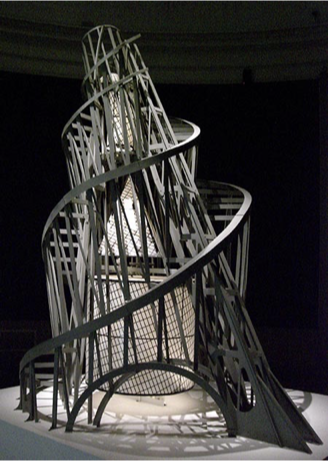
Vladimir Tatlin
Model for the
Monument to the
Third International
Russian
Constructivism
c. 1920
The generals and politicians in the Communist Party who led the Russian Revolution and set up a new government
They wanted the culture of the newly communist Russia to both create a positive atmosphere ordinary people would think was an improvement over the old traditional system
And so this aspect of reshaping Russian life needed to be put in the hands of fellow communists who were Since many of the constructivists and suprematists
Suprematists and constructivists were made the heads of art
museums and galleries, fine arts academies, design schools, unions and other professional organizations for artists and designers
communists, model represents
a proposed but never realized
architectural project that has become
one of the most recognized efforts
of this period,
The first international was the labor movement, The second international
was socialism., The third international was communism
The simple reason
this structure never got built was that
something this big and this complicated was completely beyond the capacity of the Russian economy to do
At the lowest level, the largest was
to be the meeting hall,Next up, and not quite as large, was to be the pyramid-shaped structure holding committee rooms and offices
that were subdivisions of the planetary Congress or Parliament,
smaller cylindrical tower housing the
executive offices of the President of
the World and his cabinet of heads of government departments.
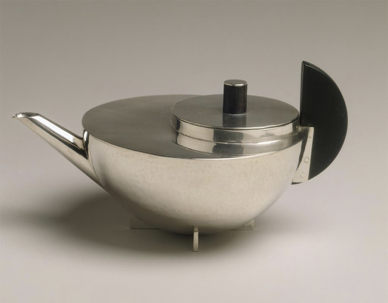
Marianne Brandt
Tea Infuser and Strainer
German, Bauhaus
One of the few women
at the Bauhaus to do something besides textiles was the metal worker and industrial designer
Marianne Brandt, who
went into the metal shop
At first, the instructors in the metal shop deliberately gave the women's
students dull, boring assignments to discourage their interests, but Brandt's talent was such that eventually she became the head of metals
Brandt focused
on handcrafted items done in a modernist geometric idiom, a rather Wiener -Wirchstetta approach
Its function is atypical. Instead of steeping dried tea leaves in hot water, it was meant to mix a concentrated tea liquid extract that was then poured into a cup
Brandt would shift into industrial design, coming up with prototypes of lighting fixtures and the like
for mass production. Her consumer products were one of the few lines designed at the Bauhaus to be manufactured by industry
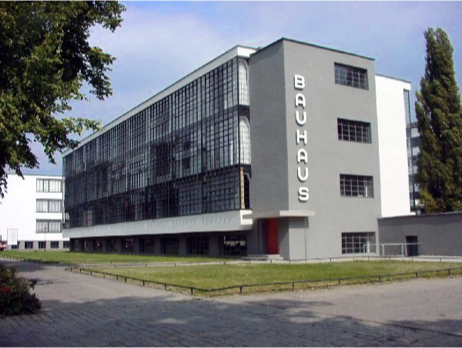
Walter Gropius, The Bauhaus, Dessau, Germany, 1925
The Bauhaus was only in operation for a few years, from 1919 to 1933, during which brief period it moved three times,
The Bauhaus had to keep moving as it continually ran afoul
of city governments that were becoming extremely conservative as the Nazi party began to coalesce and then win local elections. When the Nazis won the national election in 1933 and Adolf Hitler became
the head of state, they completely shut down the school for good